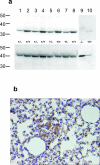BAG-1 haplo-insufficiency impairs lung tumorigenesis
- PMID: 15560850
- PMCID: PMC539250
- DOI: 10.1186/1471-2407-4-85
BAG-1 haplo-insufficiency impairs lung tumorigenesis
Abstract
Background: BAG-1 is a multifunctional co-chaperone of heat shock proteins (Hsc70/Hsp70) that is expressed in most cells. It interacts with Bcl-2 and Raf indicating that it might connect protein folding with other signaling pathways. Evidence that BAG-1 expression is frequently altered in human cancers, in particular in breast cancer, relative to normal cells has been put forward but the notion that overexpression of BAG-1 contributes to poor prognosis in tumorigenesis remains controversial.
Methods: We have evaluated the effect of BAG-1 heterozygosity in mice in a model of non-small-cell lung tumorigenesis with histological and molecular methods. We have generated mice heterozygous for BAG-1, carrying a BAG-1 null allele, that in addition express oncogenic, constitutively active C-Raf kinase (SP-C C-Raf BxB) in type II pneumocytes. SP-C C-Raf BxB mice develop multifocal adenomas early in adulthood.
Results: We show that BAG-1 heterozygosity in mice impairs C-Raf oncogene-induced lung adenoma growth. Lung tumor initiation was reduced by half in BAG-1 heterozygous SP-C C-Raf BxB mice compared to their littermates. Tumor area was reduced by 75% in 4 month lungs of BAG-1 haploinsufficient mice compared to mice with two BAG-1 copies. Whereas BAG-1 heterozygosity did not affect the rate of cell proliferation or signaling through the mitogenic cascade in adenoma cells, it increased the rate of apoptosis.
Conclusion: Reduced BAG-1 expression specifically targets tumor cells to apoptosis and impairs tumorigenesis. Our data implicate BAG-1 as a key player in oncogenic transformation by Raf and identify it as a potential molecular target for cancer treatment.
Figures




Similar articles
-
Use of mitogenic cascade blockers for treatment of C-Raf induced lung adenoma in vivo: CI-1040 strongly reduces growth and improves lung structure.BMC Cancer. 2004 Jun 1;4:24. doi: 10.1186/1471-2407-4-24. BMC Cancer. 2004. PMID: 15171791 Free PMC article.
-
Lung-targeted expression of the c-Raf-1 kinase in transgenic mice exposes a novel oncogenic character of the wild-type protein.Cell Growth Differ. 2000 Apr;11(4):185-90. Cell Growth Differ. 2000. PMID: 10775035
-
Use of a recombinant Salmonella enterica serovar Typhimurium strain expressing C-Raf for protection against C-Raf induced lung adenoma in mice.BMC Cancer. 2005 Feb 9;5:15. doi: 10.1186/1471-2407-5-15. BMC Cancer. 2005. PMID: 15703070 Free PMC article.
-
Role of Raf kinase in cancer: therapeutic potential of targeting the Raf/MEK/ERK signal transduction pathway.Semin Oncol. 2006 Aug;33(4):392-406. doi: 10.1053/j.seminoncol.2006.04.002. Semin Oncol. 2006. PMID: 16890795 Review.
-
BAG-1, an anti-apoptotic tumour marker.IUBMB Life. 2002 Feb;53(2):99-105. doi: 10.1080/15216540211473. IUBMB Life. 2002. PMID: 12049201 Review.
Cited by
-
A chaperone-assisted degradation pathway targets kinetochore proteins to ensure genome stability.PLoS Genet. 2014 Jan 30;10(1):e1004140. doi: 10.1371/journal.pgen.1004140. eCollection 2014 Jan. PLoS Genet. 2014. PMID: 24497846 Free PMC article.
-
Proteomic analysis reveals heat shock protein 70 has a key role in polycythemia Vera.Mol Cancer. 2013 Nov 19;12:142. doi: 10.1186/1476-4598-12-142. Mol Cancer. 2013. PMID: 24252366 Free PMC article.
-
A BAG-1-inhibitory peptide, GO-Pep, suppresses c-Raf activity in cancer.Commun Biol. 2025 Feb 28;8(1):336. doi: 10.1038/s42003-024-07419-4. Commun Biol. 2025. PMID: 40021821 Free PMC article.
-
Mouse models for BRAF-induced cancers.Biochem Soc Trans. 2007 Nov;35(Pt 5):1329-33. doi: 10.1042/BST0351329. Biochem Soc Trans. 2007. PMID: 17956344 Free PMC article. Review.
-
Role of BCL2-associated athanogene in resistance to platinum-based chemotherapy in non-small-cell lung cancer.Oncol Lett. 2016 Feb;11(2):984-990. doi: 10.3892/ol.2015.4003. Epub 2015 Dec 4. Oncol Lett. 2016. PMID: 26893680 Free PMC article.
References
Publication types
MeSH terms
Substances
LinkOut - more resources
Full Text Sources
Medical
Molecular Biology Databases
Research Materials
Miscellaneous

